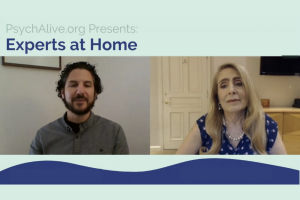How to Tame Your Inner Critic
 There are countless quotes, mantras and entire philosophies dedicated to telling us to find and follow our “inner voice.” This is a something I agree with wholeheartedly when it’s a matter of freeing ourselves from doubt and hurtful influences to discover who we really are. However, the inner voice can be tricky. Like pretty much everything and everyone in our lives, it has two sides. In fact, it’s almost as if we’re in possession of two inner voices: a positive life-affirming voice one that represents our real self (our true wants, desires and goals) and a critical, coaxing and destructive inner voice. My father Dr. Robert Firestone often refers to this internal enemy as an “anti-self” and the language of this enemy as the “critical inner voice.”
There are countless quotes, mantras and entire philosophies dedicated to telling us to find and follow our “inner voice.” This is a something I agree with wholeheartedly when it’s a matter of freeing ourselves from doubt and hurtful influences to discover who we really are. However, the inner voice can be tricky. Like pretty much everything and everyone in our lives, it has two sides. In fact, it’s almost as if we’re in possession of two inner voices: a positive life-affirming voice one that represents our real self (our true wants, desires and goals) and a critical, coaxing and destructive inner voice. My father Dr. Robert Firestone often refers to this internal enemy as an “anti-self” and the language of this enemy as the “critical inner voice.”
Getting to know and challenge this “voice” is one of the most essential psychological hurdles we can overcome in striving to live our version of our best life. For our real self to win out over our anti-self, we have to understand how our inner voices operate. Where do they come from? What’s their purpose? How can we tap into our real, positive sense of self, while quieting our critical inner voice?
We can start by understanding one major concept: we are, in many ways, ruled by our past. From the moment we’re born, we absorb the world around us. The early attitudes, beliefs and behaviors we were exposed to can become an inner dialogue, affecting how we see ourselves and others. For example, the positive behavior and qualities our parents or early caretakers had helped us form a positive sense of self as well as many of our values. If we felt love, acceptance or compassion directed toward us, this nurtured our real self and the positive feelings we have about who we are in the world. However, the critical attitudes and negative experiences we withstood formed and fueled our anti-self. Early rejections and harmful ways of relating affect a child’s budding self-perception, not to mention their point of view toward other people and relationships in general. These impressions become the voices in our heads.
No parent, or person for that matter, is perfect. We have inevitably been influenced by both the strengths and weaknesses our primary caretakers brought to the table. However, we’re not doomed to repeat their mistakes or blindly accept the beliefs we have about ourselves based on our early lives. In fact, we can constantly find ways to differentiate ourselves, connecting with the good but separating ourselves from the attitudes and beliefs that no longer serve us in the present. An important first step in this process is to take on the critical inner voice. When we come to know how this voice is harmfully shaping our present perceptions, emotions and actions, we can learn to regard it as more of an external enemy than our true point of view. There are several steps to this process:
1: Notice this voice – People often listen to their critical inner voice without realizing it. It comes through almost as background noise, so they just accept much of its commentary as reality. It’s important to become more conscious of the moments when your critical inner voice starts nagging at you. Try to notice when its undermining insults and instructions chime in throughout the day. “You look so tired/fat/ugly/stupid.” “You’re annoying people.” “You can’t do this.” “You’re such a mess.” “What’s the matter with you?”
It’s worth noting that this voice can be really mean, but it can also sometimes sound almost friendly and soothing. “Just stay home. You don’t need to worry about seeing anyone tonight.” Then, the minute you listen to its instructions, it starts to take the upper hand. “Alone again? You’re such a loser.” Don’t be fooled by the voice. Whether it sounds gentle or harsh, its main objective is to bring you down, to take you back to an old, familiar sense of your identity that continues to limit you.
2: Write your “voices” down in the second person – A powerful exercise you can do on your own is to write down the negative thoughts you have toward yourself. First, write them down in the first person as “I” statements, i.e. “I’m not fun. No one finds meinteresting.” Then, next to each of these “voices,” write the same thoughts as “you” statements. “You’re not fun. No one finds you interesting.” This process helps you start to separate your critical inner voice from your real point of view, so you can see it as the enemy it actually is.
3: Think about what or who these voices sound like – Usually when you start to list your negative thoughts, more and more tend to spill out. As this happens, especially when you switch these thoughts to the second person, these voices can start to sound familiar, like they actually come from someone else. Almost every person I’ve ever worked with doing Voice Therapy has made a connection between their voices and someone from their past. They often remark, “I felt like it was my mother talking to me” or “that expression is exactly what my father used to say.” When you make these connections, you can start to piece together where your voices originated and separate them from your current sense of self.
4: Challenge your critical inner voice – It’s very important when you write down your voices not to let your self-hating or self-shaming thoughts take over. The fourth and perhaps most essential step is, therefore, to respond to these statements from a realistic and compassionate perspective. Write down a more caring and honest response to each of your critical inner voice attacks. This time, use “I” statements. “I am a worthy person with many fun-loving qualities. I have a lot to offer.” As you do this exercise, be diligent in shutting out any rebuttals your inner critic tries to sneak in. Make a commitment to keep writing about yourself with the respect and regard you would have for a friend.
5: Connect your voices to your actions – Your critical inner voice has plenty of bad advice to dish out. “Don’t ask her out. She’ll just reject you.” “Don’t speak up. No one wants to hear what you have to say.” “Forget about relationships. He doesn’t really love you.” “Have another piece of cake. Who cares if you’re healthy?” These statements can come through loud and clear, or they can be more subtle and suggestive. As you get better at recognizing your critical inner voice, you can start to catch on when it’s starting to influence your behavior. Did you all of a sudden shut down emotionally? Get quiet? Push away a loved one? Lash out at a friend? Try to think of the events that trigger your voices and how these voices, in turn, affect your actions. Try to identify patterns and recognize self-limiting behaviors you engage in based on these voices.
6: Alter your behavior- Once you see how your inner critic can throw you off course and change your behavior, you can start to consciously act against its directives. This will likely make you uncomfortable at first. The process of tuning out your inner critic and tapping into your real self can be uplifting, but it can also cause you a lot of anxiety. These are deep-seated beliefs you’re challenging, and at first, the critical inner voice will often get louder. However, the more you actively ignore it, the weaker it will ultimately become.
Throughout the entire process of disempowering this internal enemy, there is one thing we need to practice as an opposite action that will strengthen our real self, and that is self-compassion. As researcher Dr. Kristin Neff emphasizes, unlike, self-esteem, which still lends itself to comparisons and evaluation, self-compassion focuses on self-kindness and acceptance over self-judgment. It offers a gentle way to guide ourselves back to who we really are and what we seek to be. By challenging our self-shame and cultivating our self-compassion, we establish a much stronger, more reliable view of ourselves. This point of view is not shaped by the limitations of our past but the true essence of who we are in the present and what we want for our future.
Check out Dr. Lisa Firestone’s online course “Overcome Your Inner Critic:
How to Live Free From Imagined Limitations.”










Amazing article! Thank you so much, Lisa!
[…] Read More… […]